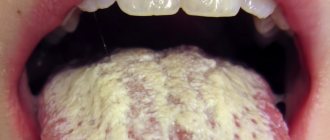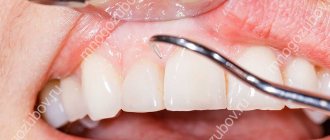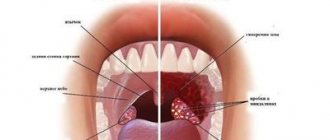Plaque in the throat (tonsils) is a common occurrence in children and adults.
And it, as a rule, is a symptom of some disease. Plaque in the throat is usually called plaque on the tonsils (tonsils). This is an organ (paired) located between the pharynx and mouth. The tonsils are easy to see if you open your mouth. There are also tonsils, which are located under the tongue, deeper in the throat, and also in the nose. They are no longer visible.
The tonsils play an important role. When entering the body, they trap viruses, microbes and bacteria, and thereby protect a person from the effects of harmful microorganisms.
The tonsils also belong to the immune system; they take part in the development of immunity. They also perform a hematopoietic function.
The tonsils are a fairly sensitive organ, especially in the cold. With reduced immunity, a person begins to have a sore throat, and the tonsils may become covered with a specific coating. Thus, they neutralize germs and viruses that enter the body through the mouth.
That is why the tonsils are called the first shield on the way to the body of harmful microorganisms . However, the role of tonsils in the immune system is not yet fully understood.
Reasons for the raid
So, plaque in the throat is a reaction of the palatine tonsils to viruses, bacteria and microbes entering the body. Plaque appears in the recesses (the so-called tonsil crypts) - food debris collects there, as well as harmful microorganisms that multiply under the influence of microflora. Then they decompose, and this leads to suppuration, which envelops the tonsils and creates plaque.
The appearance of plaque in the throat is the first signal for the body that it has been attacked by a disease and that it is necessary to urgently take measures for prevention, since the protective function of the tonsils is reduced, they cannot cope with protecting a person from further penetration of microorganisms (for example, into the trachea , bronchi, lungs, etc.).
Plaque in the throat can have various causes: • scarlet fever; • angina; • diphtheria; • candidiasis (thrush); • stomatitis; • lichen planus; • leukoplakia (leukoedema); • actinomycosis; • syphilis; • chemical burns of the mucous membrane due to taking irritating medications (for example, aspirin).
Plaque symptoms
White plaque is a common companion to many infectious diseases of the throat. A white soft mass forms in the body. It accumulates in the crypts - small depressions in the tonsils. It is this that causes bad breath, and this causes discomfort for the owner of the tonsils.
Usually this process does not cause harm to health and ends on its own, without requiring any treatment. But, as noted above, with a weakened immune system, the tonsils become an entry point for infection.
Plaque is one of the main symptoms of tonsil inflammation. Plaque can be of different colors. It depends on the stage, the specifics of the disease that develops: white plaque, gray (dirty gray), yellow; Sometimes ulcers may appear.
The entire process may be accompanied by severe pain. If you do not pay attention to the plaque at all, the infection will gradually spread and can cause the diseases mentioned above, or even lead to their complications, including heart disease, which is not immediately treatable.
Therefore, doctors advise contacting a medical facility in the following cases: • plaque does not go away for several days; • deterioration of health; • rise in temperature; • a sore throat began; • enlarged lymph nodes; • if there is a history of rheumatism; • appearance of a rash on the skin.
There is no point in trying to determine the color of plaque yourself in order to establish a more precise reason for its appearance. It is better to immediately contact a specialist (preferably an otolaryngologist), who will determine the color more reliably. It is important to determine the shade of color in order to accurately diagnose the disease and, accordingly, prescribe precise treatment. For a clear diagnosis, a throat smear is also used (determination of the type of pathogen).
Associated symptoms
White coating on the tongue is usually accompanied by the following symptoms:
- burning and dry mouth;
- increased thirst;
- increased body temperature;
- heartburn and belching;
- bad breath;
- muscle weakness and causeless fatigue;
- severe sore throat, aggravated by eating;
- craving for sweets (one of the signs of candidiasis);
- irritable bowel syndrome (diarrhea, pain, etc.) and bloating.
You should know! At the same time, some of the accompanying symptoms may be absent in certain cases (depending on the underlying disease - the root cause of the appearance of white plaque).
- White plaque in the throat: in children and adults. Causes and treatment
Sore throat without fever
Sometimes, when a plaque appears in the throat, the temperature remains normal. However, even in this case, there is no need to take risks, but still consult a doctor.
What reasons can there be for a plaque in the throat without fever: • burn, trauma to the pharynx; • fungal plaque (it looks more like a cheesy mass and affects not only the tonsils, but also the tissue of the nasopharynx); • sore throat in the initial stages; • syphilitic tonsillitis (in this case, erosions form on the thickened tonsil); • purulent plugs in lacunae (look like white plaque); • stomatitis (sore throat, no fever).
Norm and pathology
Language is a kind of mirror of the functioning of the body. When it is clean, pink, with visible taste buds, the person is healthy and most likely does not suffer from bad habits. But even a loose white coating, through which the surface of the tongue is visible, is considered as a variant of the norm. It can change shade depending on the time of year: in summer it can be more intense due to hot weather, in winter it becomes white-yellow, in autumn it becomes almost transparent. In addition, a yellow coating on the tongue in the morning appears in heavy smokers and those who drink too much coffee.
However, a change in the color of the tongue may be a consequence of malfunctions in the internal organs, mainly the liver, kidneys, stomach, pancreas and gall bladder. If the plaque has become dense, thick, bright yellow or brownish-yellow, and there is also bad breath, you should consult a doctor and identify the cause of the problem.
Attention!
Typically, “safe” soft deposits come off easily and, if brushed well, will not reappear. But if the plaque returns, we are dealing with pathology.
White plaque
Diseases that may cause white plaque on the tonsils: • sore throat; • leukoplakia (another name is leukoedema); • scarlet fever; • candidiasis (thrush); • actinomycosis; • stomatitis; • burns of the mucous membrane of the mouth and throat.
Leukoplakia (leukoedema)
This is called swelling of the oral mucosa. It occurs more often in people who smoke or sniff tobacco. The causes of the violation have not been studied. These disorders are quite common, but are not cause for great concern. With this disease, changes in the mucosa are not common. However, it is necessary to be under the supervision of a specialist, since there is a risk of developing cancer. And such a disease, as we know, is easiest to treat in the early stages. Although in 80% of cases the plaques are benign .
If the white plaques suddenly thicken, then it is advisable to submit a piece of tissue for a detailed cytological examination to clarify the nature of the disease. The substance is taken for analysis under local anesthesia, so as not to cause discomfort to the patient.
To prevent leukoplakia, doctors advise giving up chewing tobacco and smoking, because these unhealthy habits can become a trigger for the development of the disease.
For the treatment of leukoplakia, carotene is prescribed in large doses for a month. Vitamin A therapy should be carried out under the close supervision of a doctor, since any overdose can cause damage to health.
Angina
In most cases, white plaque means tonsillitis - inflammation of the tonsils. There are many types of sore throat. White plaque means lacunar tonsillitis. The main symptoms of lacunar tonsillitis: • white coating on the tonsils, has a yellowish tint; • plaque covers the entire tonsils; • plaque can be easily removed with a spatula; • general weakness; • acute sore throat; • elevated temperature.
Purulent plaque
With follicular (purulent) tonsillitis, ulcers form on the tonsils. The festering follicles are visible through the mucous membrane.
Symptoms of follicular tonsillitis: • high temperature; • very poor general health; • lack of appetite; • weakness; • headache.
This type of sore throat takes a long time to treat and is difficult. May develop into a chronic form. Then, even with a minor cold, a person suffers from purulent plaque on the tonsils. If the sore throat is purulent, the doctor will prescribe antibiotics. For follicular sore throat, home treatment methods (herbs, rinses, poultices) will be completely insufficient, and sometimes traditional methods can be dangerous.
If you have a sore throat, it is important to consult a doctor about how to remove pus from the tonsils. Therapy and prevention must be taken very seriously to prevent the disease from returning.
Scarlet fever
Symptoms: • plaque in the throat; • pain when swallowing; • general weakness; • headache; • temperature; • nausea; • drowsiness (persistent); • swelling.
Syphilis
Damage to the mucous membrane of the trays with syphilis has a whitish tint. Three weeks after the onset of the disease, they turn red.
Actinomycosis
Occurs in people who are accustomed to chewing grass stems. This habit causes fungal infections in the oral mucosa. Actinomycosis appears as a white coating on the tongue and palate.
Lichen planus
Damage to the oral mucosa. Resembles a white grille in appearance. The disease does not require therapy if there is no pain. It is caused by malfunctions in the body's defense system - autoimmune reactions. No special treatment is required if there is no pain.
Thrush (candidiasis)
Symptoms: • white plaque on the tonsils; • gradually spreads to the entire mouth.
Stomatitis
Main symptoms: • slight plaque in the mouth; • irritation of ulcers during meals; • temperature increase.
Burns to the mucous membranes of the mouth and throat
Occur as a result of resorption of tablets (for example, aspirin) or after exposure to other chemicals. The burn areas appear to turn white.
Causes of white plaque
The simplest reason for the appearance of plaque is insufficient oral hygiene. The immune system deals with bacteria on its own, leaving the person to “admire” the accumulation of dead bacteria and antibodies in the form of a corresponding plaque. Hygiene measures need to be strengthened. There are many other reasons, the most common are:
- Thrush or candidiasis (mycosis of the pharynx): affects people with weakened immune systems or who have been infected with the Candida microbe. The tongue and tonsils are covered with a white layer.
- Sore throat: a light coating appears on the back of the throat, sometimes tending to yellowish, and pain occurs when swallowing. The pathogen is very strong, so treatment with antibiotics is required.
- Scarlet fever: fever and headache are added to the plaque. There is pain in the throat, itching and nausea gradually appear.
- Stomatitis: colonies of fungal microorganisms are localized on individual segments of the pharynx and throat, the plug becomes white.
- Leukoplakia is a disease of smokers in which epithelial cells die from tobacco smoke. The affected areas turn white, and there is a risk of cancer.
- If the patient has diphtheria, the plaque is accompanied by swelling of the tonsils and headache.
White plaque on tonsils without fever
The first reason that comes to mind when a whitish coating appears on the tonsils is a sore throat. Indeed, this may be a sign of an atypical form of Simanovsky-Vincent angina, the causative agent of which is a spindle-shaped rod and a spirochete. Along with a sore throat, a person may encounter diseases in which the temperature is not expressed:
- Chronic tonsillitis: The white segments on the epithelium of the throat are pus formed from food debris, dead epithelium and bacteria. Tonsillitis is dangerous due to complications such as kidney and heart disease.
- Fungal diseases: yeast-like cultures begin to multiply on the tonsils due to decreased immunity.
- Cysts on the tonsils: clearly visible white bumps.
- Injuries to the tonsils: during regeneration, the wounded surface is covered with a temporary white or gray film.
- Dental pathologies: ulcers appear throughout the oral cavity, on the tonsils. Gradually, the ulcers epithelialize and ulcers form.
White dots on tonsils, throat does not hurt
The cause of non-painful white spots similar to pus found on the tonsils may be the simple consumption of fermented milk products. Such points pass after rinsing with boiled water. The absence of pain may indicate a fungal etiology of the disease or the initial stage of an infectious disease, the symptoms of which will increase gradually.
- Sore throat and fever, weakness in the body - what could it be? What to drink for these symptoms
Red throat with white coating
Redness indicates an inflammatory process in the throat. This is typical for damage to the body by a viral or bacterial infection. A red throat with a coating can be caused by the following diseases, the final decision on which must be made taking into account the entire range of symptoms:
- diphtheria;
- tonsillitis;
- pharyngitis;
- stomatitis.
Gray plaque on tonsils
Diphtheria
A rather dangerous acute infectious disease is diphtheria. Its harbingers are white dots on the tonsils. The coating has a grayish, dirty tint.
The infection is transmitted from a sick person to a healthy one. Pathogenic microorganisms (rod-shaped microbes) can penetrate the mucous membranes of the eyes, upper respiratory tract, genitals and skin.
Depending on the place of introduction of the diphtheria bacillus, there are several types of diphtheria: • diphtheria of the pharynx; • diphtheria of the larynx; • nasal diphtheria; • eye diphtheria; • diphtheria wounds.
If the diphtheria bacillus enters through the mouth, it leads to inflammation in the pharynx and plaque on the tonsils.
There are different forms of diphtheria of the throat. If the form is localized, then the plaque is almost visible; it resembles a film with a gray pearlescent sheen.
With toxic diphtheria, the plaque is dirty gray crusts, very painful. If the form is common, then the plaque can be from light gray to dark gray, and the plaque is located not only on the tonsils themselves, but also beyond them.
What are white dots on the tonsils
Plaque can take the form of single white dots of varying sizes - from one to several millimeters. Their consistency can be soft, cheesy (caseous), dense or hard.
Every day, the tonsils encounter microbes that enter through the nasopharynx. In the lacunae, pathogenic microorganisms come into contact with the epithelium of the tonsils. In response to the penetration of bacteria, local inflammation develops. It activates the immune system and the production of antibodies.
The epicenter of resistance to infection is the follicles of the tonsils. They are groups of lymphoid immunocompetent cells. The result of the struggle is accumulation of destroyed cells and bacteria in the lacunae and at the site of the follicles. Gradually the plugs are impregnated with calcium salts and harden.
The resulting white dots on the tonsils consist of:
- from the remains of dead leukocytes;
- destroyed epithelial cells;
- microbes;
- calcium salts.
Bacterial examination of the contents of plugs reveals streptococci, staphylococci, and pneumococci.
What kind of disease is this and what are its causes?
Chronic tonsillitis is the most common cause of plug formation.
In addition, white lumps on the tonsils may appear:
- with weakened immunity;
- frequent sore throats;
- herpetic infection;
- fungal infection - candidiasis;
- caries;
- viral infections - influenza, ARVI.
With and without fever
The appearance of white spots on the tonsils may be accompanied by an increase in temperature. This is observed:
- with follicular or lacunar tonsillitis;
- influenza and acute respiratory viral diseases;
- herpetic infection;
- exacerbation of chronic tonsillitis.
The tonsils enlarge, their hyperemia and swelling are revealed, their surface loosens.
White spots on the tonsils may appear without fever. This happens:
- with candidiasis;
- with chronic tonsillitis without exacerbation.
To establish the cause of white dots on the tonsils, it is necessary to do a bacteriological analysis of them.
White lumps with an unpleasant odor
With chronic tonsillitis, white lumps with an unpleasant odor appear in the tonsils. They often have a cheesy or hard consistency. They are called tonsilloliths. The putrid odor is caused by the activity of pathogenic microorganisms. The disease occurs without sore throat.
With inflammatory processes in the throat or nasopharynx, tonsillitis increases.
Other symptoms
With exacerbation of chronic tonsillitis, follicular or lacunar tonsillitis, in addition to plaque on the tonsils, there is a sore throat, difficulty swallowing, enlargement and tenderness of the submandibular lymph nodes. Symptoms of intoxication appear: headache, weakness, lack of appetite. At night there may be heavy sweats and sleep disturbances.
With acute respiratory viral infections, patients complain of body aches, pain in the muscles and when moving the eyeballs, cough, runny nose, and chest congestion.
Yellow plaque
Such plaque may be a sign of the same diseases as white plaque, however, the shade is individual for each person, since it depends on various factors.
Sometimes a yellow coating can indicate the first stage of the appearance of pus on the tonsils, and subsequently this pus can turn into very painful ulcers.
Yellow plaque most often accompanies a sore throat (tonsillitis), especially if it is accompanied by difficulty breathing, cough, high temperature, and sore throat.
The main therapy is carried out with antibiotics, since the causative agents of sore throat are bacteria. Traditional medicine can alleviate some of the symptoms of the disease.
Fungal plaque
Often children and adults have a fungal type of plaque. It is caused by a fungus of the genus Candida, which penetrates the mucous membrane of the oral cavity, nose and mouth, and eyes. The difference between fungal sore throat and any other is that it cannot be treated with antibiotics. Antifungal medications and vitamins will be required. If the fungus cannot be cured with medications, then they resort to surgery - removal of the tonsils.
Fibrinous plaque after tonsillectomy
Tonsil removal surgery can have complications, just like any other surgery. In particular, pharyngeal bleeding may occur on the first day or one day after surgery. It occurs when the patient does not follow the doctor’s recommendations regarding the postoperative regimen.
After the operation, an open wound is formed at the site of the removed tonsils. Over time, the wound is covered with a fibrinous film, which serves as a hemostatic barrier. And approximately 5 days after tonsillectomy, fibrinous plaque on the tonsils disappears on its own .
Curdled coating
With pharyngomycosis, candidiasis of the tonsils, mycosis of the pharynx, plaque in the throat has a thick curd consistency. After the fungus infects the oral mucosa, a whitish or grayish coating appears. It can be removed quite easily, but after a while it appears again. In this case, the patient may have bad breath, since plaque occurs as a result of the functioning and decomposition of microorganisms.
A person may have several types of fungi present at the same time. If a cheesy coating appears in your mouth, you should consult a doctor. There are many drugs for fungus, but each has its own specifics, it is aimed against certain types of fungi, so it is important to choose the right one.
Sore throat in a child
Children have weaker immunity than adults. Children's tonsils cannot cope well with infections that await them in kindergarten or school, or on the street, especially if these infections are spread by airborne droplets. For these reasons, children more often than adults suffer from sore throats and fungal diseases of the mouth and pharynx.
A child’s tonsils sometimes immediately react to the introduction of the disease by the appearance of plaque. There is no need to hesitate to see a doctor; you should not wait for the disease to develop or, worse, complications .
Experts recommend that parents engage in timely prevention of diseases in children and strengthen their immune system.
Diagnostics
Diagnosis of plaque on the tonsils itself is simple. You need to stand facing the light source, take a mirror, open your mouth and look - the plaque will be immediately visible. But only a doctor can understand the nature of the infection and determine the type of fungus or microbe after conducting appropriate studies (analysis of a smear from the mucous membrane of the nasopharynx and pharynx).
What characteristics are taken into account when analyzing plaque: • results of a smear from the mucous membranes; • plaque color; • plaque consistency; • presence or absence of ulcers on the tonsils; • presence of fever; • presence or absence of sore throat.
There is no need to try to make a diagnosis yourself; it is better to consult an otolaryngologist. After all, any disease is fraught with transition to the chronic stage, and there is also a high risk of infection of the immediate environment.
How to deal with plaque in the throat
Leukoedema (leukoplakia) does not require self-treatment. With lichen planus there is also no particular danger. But if there is pain when swallowing, the doctor will most likely prescribe hydrocortisone (tablets or ointment).
When the first symptoms of a viral infection occur (plaque on the tonsils, fever, general weakness, sore throat), it is advisable to take an antiviral drug (for example, Amizon, Amixin).
To soothe a sore throat and remove plaque, including sore throat and pharyngitis, rinsing is recommended - the most popular and accessible method of symptomatic treatment. Options for gargling solutions for a sore throat: • saline (or soda) solution with added iodine - half a teaspoon of salt or soda + 3 drops of iodine per 1 glass of warm (not hot!) water. Carry out the procedure often, after meals; • rinsing with furatsilin solution - a ready-made pharmaceutical solution or prepared at home from tablets. Take one tablet, crush it and pour a glass of boiling water. Rinse with warm solution several times a day; • for stomatitis and inflamed tonsils, gargling with the pharmaceutical solution “Stomatidin” helps. For a sore throat, lozenges with an analgesic effect can help - decatylene, faringosept, septefril, etc.
What diseases cause the throat to turn red?
Pharyngitis, or inflammation of the pharynx, is one of the most common causes of redness of the throat. The disease can occur acutely or chronically1.
Acute pharyngitis
In 70% of cases, it accompanies ARVI and is more often associated with rhinovirus infection, which is especially common in the autumn2. In addition, influenza viruses, parainfluenza, adenoviruses, and respiratory syncytial virus can cause inflammation.
With viral pharyngitis, the throat looks red, “dry”, and the main complaints are soreness, dryness and pain in the throat, causing an obsessive superficial cough. The general condition depends on the nature of ARVI.
Viral inflammation often paves the way for bacterial infection2 caused by staphylococci, streptococci, neisseria, chlamydia, mycoplasma1. Bacterial pharyngitis is usually purulent and is characterized by an increase in temperature to 38°C or higher, and the appearance of purulent sputum.
Attention! Pharyngitis can be one of the first manifestations of “childhood” infections: measles, scarlet fever, rubella2. In adults, these infections are often severe and lead to complications2. Only a doctor can make the correct diagnosis.
In addition to viruses and bacteria, the cause of acute pharyngitis can be:
- allergic reactions1,2;
- diseases of the digestive system, in which the acidic contents of the stomach are thrown into the esophagus and pharynx (this includes cardial insufficiency and reflux esophagitis)1,2;
- tumor formations of the pharynx, including malignant1;
- specific infectious and inflammatory diseases (syphilis, tuberculosis, candidiasis)1.
Up to contents
Chronic pharyngitis
Its development can be caused by 3:
| Frequent colds | recurrent (repeating) acute respiratory diseases, which affect the upper respiratory tract and impair nasal breathing: rhinitis, sinusitis, adenoiditis |
| Gastropharyngeal reflux | periodic reflux of stomach contents into the esophagus and pharynx |
| General diseases | diabetes mellitus, renal and liver failure, immunodeficiency states3 |
Chronic pharyngitis can occur in three forms: catarrhal, hypertrophic and atrophic3.
With catarrhal inflammation, the throat is red, swollen, and there is discomfort: pain, soreness, tickling, sensation of a foreign body in the throat3.
Hypertrophic pharyngitis leads to thickening of the mucous membrane and proliferation of lymphoid formations. The walls of the pharynx become red, moist, and covered with a network of dilated blood vessels. Discomfort in the throat may be accompanied by a feeling of a foreign body in the throat and stuffy ears3.
Atrophic processes associated with tissue malnutrition are accompanied by thinning of the pharyngeal mucosa. Upon examination, it looks “dry”, “tight”, “granules” of lymphoid tissue rise above the general surface. The main complaints are dry throat and a dry, superficial cough that occurs at the slightest irritation of the respiratory tract3.
By the way, the development of atrophic pharyngitis is sometimes associated with frequent and prolonged instillation of vasoconstrictor drugs into the nose. Flowing into the nasopharynx, these drugs cause spasm of blood vessels, impair the nutrition of the mucous membrane and provoke its atrophy3.
Chronic pharyngitis is not common in children. Its development is facilitated by postnasal drip - the flow of mucus into the throat from the nasal cavity and paranasal sinuses. In this case, wheezing, reminiscent of bronchial asthma, may appear. Special examination helps to exclude the disease2.
A chronic inflammatory process in the pharynx weakens its protective functions and predisposes to frequent acute respiratory viral infections. Exacerbation of pharyngitis is facilitated by hypothermia of the throat in winter, inhalation of hot steam and air during inhalation, in a bath or sauna, consumption of hard, hot and spicy, excessively sweet and salty foods, alcoholic beverages, etc.3.
Up to contents
Treatment of plaque in the throat with traditional methods
You can try to treat plaque on the tonsils with folk remedies: • gargling with tinctures or infusions of medicinal flowers and herbs (chamomile, calendula, sage). Take one tablespoon per glass of boiling water, leave for 15-20 minutes, then strain. Rinse several times a day, the infusion should be warm. You can take a collection of herbs; • gargling with water in which beets have been boiled (helps with sore throat). Before boiling beets, of course, you need to rinse them thoroughly. Perform this rinsing procedure twice a day; • chewing small pieces of garlic. Garlic juice helps destroy bacteria; • chewing lemon slices, drinking tea with lemon (lemon juice cleanses the tonsils well and has pain-relieving properties); • resorption of a small amount of honey in the mouth (in the absence of allergies to bee products). Can be done often. Honey is known to have antibacterial properties; • onion inhalations. Grind the onion (it is very rich in phytoncides) into a puree. Bend low over the bowl of this puree and inhale deeply through your mouth for about 5 minutes. Repeat twice or thrice a day. Following such simple folk recommendations helps to quickly cope with diseases.
Additional events
• hydration of the oral cavity. Some doctors recommend drinking an extra glass of water with meals and before bed (unless you have kidney disease); • additional air humidification (installation of humidifiers, growing indoor plants, etc.); • frequent ventilation of the room.










